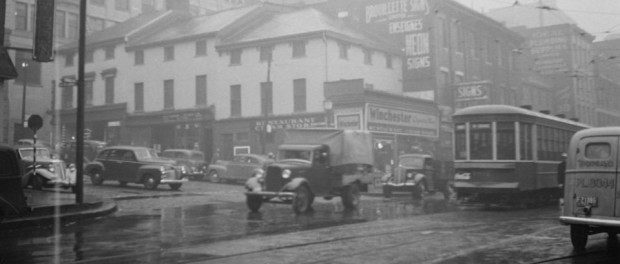The Main & Other Quebec Curios
 The intersection of Saint Lawrence Boulevard and Craig Street on a rainy day in October 1941. Photographed by Conrad Poirier. Photo courtesy Pistard/BAnQ (P48,S1,P6888)
The intersection of Saint Lawrence Boulevard and Craig Street on a rainy day in October 1941. Photographed by Conrad Poirier. Photo courtesy Pistard/BAnQ (P48,S1,P6888)
“Oh, East is East and West is West, and never the twain shall meet.”
(Rudyard Kipling, “The Ballad of East and West”)
The Main is the physical and cultural divide between the western Anglophones and the eastern Francophones. For the many immigrants during and following World War II, it was a stepping stone of sorts, a first home, a new life. The area around the Main and “Park Avenue” (avenue du Parc) is the place out of which writers such as Irving Layton, Michel Tremblay, and Leonard Cohen came. Mordecai Richler’s Duddy, Jake, and Joshua all grow up around the Main and St. Urbain Street, popular working class locations with a vibrant Jewish community, a community that openly supported a federal politician with Communist leanings, a first (and possibly last, for a long while) for Canada. But Saint Lawrence Boulevard, as it is identified on reputable maps, goes back, much farther, to the 1600s, when it was part of a seigneurie and named Saint-Lambert, after a sergeant that died defending Montreal.
Saint-Lambert Street was renamed in 1720, around the time when the town of Saint-Lawrence was founded; the oldest buildings on the street, not much of a surprise here, are churches from the same era. The famous east-west divide has its origins in the 1700s as well: as the city of Saint-Lawrence grew, a proclamation in 1792 (one year after the Canada Act, creating Upper and Lower Canada) separated the boulevard into “east” and “west”. The divide became noticeable as the English-speaking bourgeois moved to the north and west of the boulevard, the French bourgeois to the north and the east, and lower-class workers of both languages to the south, on both sides. Newly-arrived immigrants would often settle in the middle.
From the red-light district crossing Saint Catherine to the Mile End and still northwards, the Main was not only a linguistic divide but also an ethnic divide as well. Chinatown is the one that immediately comes to mind with its four red paifangs and the guardian lions flanking each archway. Originally part of the Jewish quarter (a quarter that declined in the 1950s), Chinatown is now a vibrant community with its own hospital and various newspapers. Little Italy is also another ethnic community, with its Jean-Talon Market and a population that rivals all other Italian populations in Canada other than Toronto, along with Little Portugal near the Plateau.
Today, the linguistic divide of the Main is symbolic, as French and English people live on both sides of the boulevard. Times have changed -— or have they? One could say that there is a new linguistic divide: that of English west of the Highway 40 and, well, everybody else to the east…






